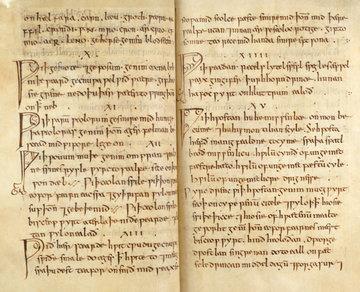A mediaeval remedy used to cure a “lump in the eye” - interpreted as a sign of bacterial infection - more than 1,000 years ago has been reworked into a pharmaceutical product with potent antibiofilm activity, delegates will hear at the Letters in Applied Microbiology ECS Research Symposium.

Bald’s Eyesalve is a remedy containing garlic, another Allium species, wine and bile salts, described in the 10th-century Anglo-Saxon Bald’s Leechbook and described as a treatment for a “wen”, a lump in the eye. A common cause of a lump in the eye is a stye, which results from bacterial biofilm infection of the eyelash follicle.
Oluwatosin Orababa, from the University of Warwick, is presenting his PhD research: ‘From mediaeval wisdom to modern mastery: unravelling the antibiofilm potential of Bald’s eyesalve and its derived cocktail’. He is part of the Ancientbiotics consortium, a network of scientists and arts and humanities researchers who are exploring mediaeval infection remedies which had been neglected since the discovery of antibiotics.
New antimicrobials from old sources
The increasing mortality associated with antimicrobial resistance now necessitates the discovery of new antimicrobials from both novel and old sources, Mr Orababa says.
“We have identified a complex mediaeval remedy called Bald’s eyesalve – used more than 1,000 years ago – with good antibacterial and antibiofilm activity against a wide range of bacterial pathogens,” he says.

“At the Harrison lab, School of Life Sciences, University of Warwick, we have investigated the molecules present in this complex remedy and created a well-defined and simple cocktail of natural products with potent antibiofilm activity (both biofilm eradication and prevention). This has the potential to be developed into a treatment for chronic wounds and cystic fibrosis lung infections.”
Biofilm-associated infections
Biofilm-associated infections are highly resistant to antimicrobials and difficult to treat. They account for more than 80% of all chronic microbial infections (including chronic wounds and cystic fibrosis lung infection) and are associated with millions of dollars in healthcare costs.
The lab, working with collaborators from other universities in the UK and USA, has previously shown that Bald’s eyesalve has good antibiofilm activity, and Mr Orababa’s PhD research aims to develop an improved, simple, and well-defined natural product cocktail from Bald’s eyesalve, and to understand its mechanism of action against bacterial pathogens.
“Using host mimicking media and infection models such as an in vitro soft tissue wound model and ex vivo pig lung model of cystic fibrosis biofilm, we have developed a simple, and well-defined natural product cocktail from Bald’s eyesalve,” he says.
Broad-spectrium antibiofilm activity
“I have shown that this has potent broad-spectrum antibiofilm activity against drug-resistant pathogens including methicillin-resistant Staphylococcus aureus, Acinetobacter baumannii, and Pseudomonas aeruginosa in both chronic wound and cystic fibrosis lung infection models. This activity cannot be explained by one molecule alone. I have also shown that this remedy has rapid bactericidal activity against these pathogens – it eliminates free-floating (planktonic) bacterial cells in less than three hours.

“It is interesting to know that a remedy that was used more than 1,000 years ago has potent activity against current drug-resistant pathogens and could now be developed into a clinically relevant treatment for chronic biofilm infections like chronic wounds - like medical grade honey which is an approved NHS treatment for wound infection prevention and treatment.
Wound treatments
“An effective wound treatment would reduce the risks of amputation and the mortality rate associated with chronic wound infections. Additionally, this would reduce the use of antibiotics in wound therapy and consequently reduce the risk of antimicrobial resistance in the clinic.
“Due to the increasing resistance of pathogens to antimicrobials, looking into old natural remedies that were used for infection treatment in the pre-antibiotic era might be a potential solution. There is a need for more funding to research these remedies, identify their active components and create modern-day drugs from them to reduce the pressure on conventional antibiotics.”
This study is led by Dr Freya Harrison from the School of Life Sciences, University of Warwick. Previous data on the activity and safety of Bald’s eyesalve in the lab were obtained by Dr Jessica Furner-Pardoe during her PhD and Dr Blessing Anonye during her post-doctoral Fellowship in Warwick, aided by a large number of other team members past and present at the University of Warwick, University of Nottingham, Texas Tech University and Kingston University London. Prof Christophe Corre at the University of Warwick is also providing chemistry expertise as part of the PhD research. Lastly, the PhD is funded by the BBSRC through the MIBTP Doctoral Training Partnership.
Topics
- Acinetobacter baumannii
- Ancientbiotics consortium
- Antimicrobial Resistance
- Applied Microbiology International
- Bacteria
- Bald’s Eyesalve
- Biofilms
- Blessing Anonye
- Christophe Corre
- Community
- cystic fibrosis
- Early Career Research
- Freya Harrison
- Jessica Furner-Pardoe
- Kingston University London
- Medical Microbiology
- MRSA
- Oluwatosin Orababa
- One Health
- Pharmaceutical Microbiology
- Pseudomonas aeruginosa
- Research News
- Texas Tech University
- traditional medicine
- UK & Rest of Europe
- University of Nottingham
- University of Warwick
- wound healing







No comments yet